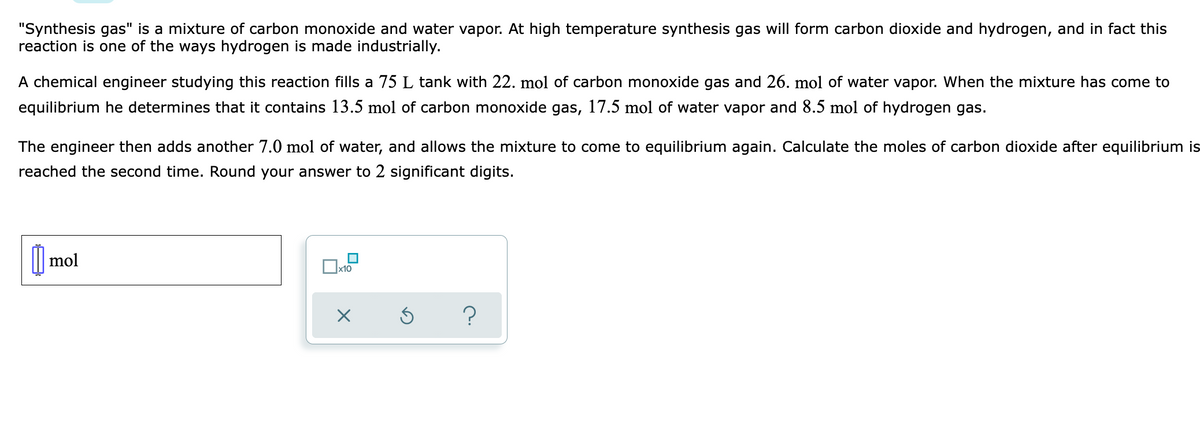"Synthesis gas" is a mixture of carbon monoxide and water vapor. At high temperature synthesis gas will form carbon dioxide and hydrogen, and in fact this reaction is one of the ways hydrogen is made industrially. A chemical engineer studying this reaction fills a 75 L tank with 22. mol of carbon monoxide gas and 26. mol of water vapor. When the mixture has come to equilibrium he determines that it contains 13.5 mol of carbon monoxide gas, 17.5 mol of water vapor and 8.5 mol of hydrogen gas. The engineer then adds another 7.0 mol of water, and allows the mixture to come to equilibrium again. Calculate the moles of carbon dioxide after equilibrium reached the second time. Round your answer to 2 significant digits. | mol
"Synthesis gas" is a mixture of carbon monoxide and water vapor. At high temperature synthesis gas will form carbon dioxide and hydrogen, and in fact this reaction is one of the ways hydrogen is made industrially. A chemical engineer studying this reaction fills a 75 L tank with 22. mol of carbon monoxide gas and 26. mol of water vapor. When the mixture has come to equilibrium he determines that it contains 13.5 mol of carbon monoxide gas, 17.5 mol of water vapor and 8.5 mol of hydrogen gas. The engineer then adds another 7.0 mol of water, and allows the mixture to come to equilibrium again. Calculate the moles of carbon dioxide after equilibrium reached the second time. Round your answer to 2 significant digits. | mol
Chapter5: Gases
Section: Chapter Questions
Problem 129AE: The nitrogen content of organic compounds can be determined by the Dumas method. The compound in...
Related questions
Question

Transcribed Image Text:"Synthesis gas" is a mixture of carbon monoxide and water vapor. At high temperature synthesis gas will form carbon dioxide and hydrogen, and in fact this
reaction is one of the ways hydrogen is made industrially.
A chemical engineer studying this reaction fills a 75 L tank with 22. mol of carbon monoxide gas and 26. mol of water vapor. When the mixture has come to
equilibrium he determines that it contains 13.5 mol of carbon monoxide gas, 17.5 mol of water vapor and 8.5 mol of hydrogen gas.
The engineer then adds another 7.0 mol of water, and allows the mixture to come to equilibrium again. Calculate the moles of carbon dioxide after equilibrium is
reached the second time. Round your answer to 2 significant digits.
|| mol
x10
Expert Solution
This question has been solved!
Explore an expertly crafted, step-by-step solution for a thorough understanding of key concepts.
This is a popular solution!
Trending now
This is a popular solution!
Step by step
Solved in 3 steps with 3 images

Knowledge Booster
Learn more about
Need a deep-dive on the concept behind this application? Look no further. Learn more about this topic, chemistry and related others by exploring similar questions and additional content below.Recommended textbooks for you


Chemistry: An Atoms First Approach
Chemistry
ISBN:
9781305079243
Author:
Steven S. Zumdahl, Susan A. Zumdahl
Publisher:
Cengage Learning

Chemistry
Chemistry
ISBN:
9781305957404
Author:
Steven S. Zumdahl, Susan A. Zumdahl, Donald J. DeCoste
Publisher:
Cengage Learning


Chemistry: An Atoms First Approach
Chemistry
ISBN:
9781305079243
Author:
Steven S. Zumdahl, Susan A. Zumdahl
Publisher:
Cengage Learning

Chemistry
Chemistry
ISBN:
9781305957404
Author:
Steven S. Zumdahl, Susan A. Zumdahl, Donald J. DeCoste
Publisher:
Cengage Learning

General Chemistry - Standalone book (MindTap Cour…
Chemistry
ISBN:
9781305580343
Author:
Steven D. Gammon, Ebbing, Darrell Ebbing, Steven D., Darrell; Gammon, Darrell Ebbing; Steven D. Gammon, Darrell D.; Gammon, Ebbing; Steven D. Gammon; Darrell
Publisher:
Cengage Learning

Chemistry & Chemical Reactivity
Chemistry
ISBN:
9781337399074
Author:
John C. Kotz, Paul M. Treichel, John Townsend, David Treichel
Publisher:
Cengage Learning

Chemistry: Matter and Change
Chemistry
ISBN:
9780078746376
Author:
Dinah Zike, Laurel Dingrando, Nicholas Hainen, Cheryl Wistrom
Publisher:
Glencoe/McGraw-Hill School Pub Co